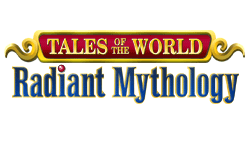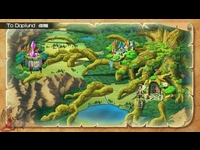|
|

|
PLATFORM
|
PSP
|
BATTLE SYSTEM
|

|
INTERACTION
|

|
ORIGINALITY
|

|
STORY
|

|
MUSIC & SOUND
|

|
VISUALS
|

|
CHALLENGE
|
Easy
|
COMPLETION TIME
|
20-40 Hours
|
|
OVERALL

|
- Terrible AI.
- Switching to a new class requires starting at level one.
- Tedious, uninspired sidequests are required to advance the story.
- Can only accept one sidequest at a time.
- Game sends you to the same bland dungeons repeatedly.
- Tales characters regularly refuse to join your party.
|
Click here for scoring definitions
|
|
|
It's hard being a Tales fan in the western world. The will-they/won't-they relationship of Namco Bandai and the Tales series rivals the best TV sitcoms out there, and infuriates those who eagerly await word of impending releases. The localization practices of Namco Bandai are random at best and psychotic at worst, but by far the weirdest and most infuriating of all was their decision to release Tales of the World: Radiant Mythology on the PSP. This game, whose primary audience is die-hard Tales fans, is a niche within the already slim niche the Tales games occupy, making it easily one of the most baffling decisions the corporation has ever made. Even worse: the game is absolutely awful.
Radiant Mythology takes place in some sort of odd crossroads world, where (as far as I can gather) refugees from other worlds have gathered after their homes were destroyed by a menacing creature that literally devours planets — a creature that now has its sights set on the hero's world of Terresia. These refugees, of course, are characters from Tales titles throughout the series. The player takes on the role of the Descender, a being created by the World Tree to protect the planet in its time of crisis. As the Descender, you take on various requests and jobs from the townspeople while simultaneously attempting to solve the crisis threatening the world.
While not utterly abominable, the plotline in the game is razor thin and generally rather bland. Radiant Mythology sports a small handful of decent original characters, but more than anything, the entire story is an excuse to throw together dozens upon dozens of skits and small scenes with characters from previous games. For Tales fans this can be quite entertaining, but it doesn't do much for the story when the game has dozens of different characters all relying on previous titles for any sort of character development. As they're presented in Radiant Mythology, they're entirely static and show no growth whatsoever, an unfortunate issue that eliminates much of what made them interesting to begin with. The story, however, is in a supporting role in Radiant Mythology, with the core gameplay holding the entire package together. Unfortunately, the core gameplay is a drab, uninspired, and generally tedious affair that sports some of the worst game and level design imaginable.
The one and only element of Radiant Mythology's gameplay that manages to stand out as actually being fairly decent is the combat system. A modified version of the combat system introduced in Tales of the Abyss, Radiant Mythology actually manages to make it run quite well with a handful of tweaked controls. Free-running is accomplished simply by moving the PSP's analog nub, while the D-Pad is strictly bound to linear movement and skill activation. Anyone who's played Tales of the Abyss will likely recall regularly switching between the D-Pad and the analog stick for the same purpose, so this adjustment is actually quite pleasant. However, not everything went right with the transfer to the PSP. The combat feels more sluggish than other Tales titles, and character AI is incredibly stupid, particularly among healers. Item use ends up being very important, particularly towards the end of the game, as the healers just can't keep up.
 The town maps are one of the only things in this game that seems to have been given any thought.
The town maps are one of the only things in this game that seems to have been given any thought.
|
|
The game spirals downwards from here. Radiant Mythology sports a fairly robust class system, with just shy of a dozen classes based on various characters' fighting styles throughout the series. Unfortunately, all but six of these have to be unlocked through side quests, and each class's level is separated from the others; if you start a new class, you have to return to level one. The side quests that unlock these classes are quite well hidden and aren't even guaranteed to show up. Even should you know which one you're looking for, the quest list is randomly generated each time you enter town, so you may have to leave and come back several times just to find it. Some of these quests don't even show up until you've gotten a different class to level 30.
The quest structure itself is a nightmare to begin with. Each of the three towns in the game has a guild, which doles out quests to those willing to take them. Unfortunately, players can only accept one quest at a time, despite the fact that most of them take place in the same dungeons. As a result, players will have to take a quest, complete it, and then take another one, heading back into the same dungeon over and over and over. All told, there are less than ten dungeons in the game, and players will have to enter each of them dozens of times over the course of the game.
If these were merely sidequests, it might not be so bad, but the game is structured in such a way that completing sidequests is necessary in order to advance the story. Story quests only appear once enough fame points are earned, and fame points are earned — you guessed it — by completing sidequests. This is the incredibly monotonous and ultimate reality of Radiant Mythology: the same dungeons over and over again until you finally have enough fame points to advance.
Of course, one of the main draws of any crossover fandom game is the ability to create a dream team of characters from across the series. Unfortunately, Radiant Mythology likes to make that as hard as possible. Sure, there are plenty of Tales characters from across the series, but actually making use of them is about as difficult and frustrating as it comes. To start with, characters are separated between towns, and characters can only be recruited from the towns in which they're based. The Phantasia and Symphonia characters are all based in the first town, the Destiny, Destiny II, and Eternia characters are all based in the second town, and the Abyss, Legendia, and Rebirth characters are all based in the third town. If you wanted to create a team of Lloyd, Leon, and Luke, you would have to visit each of the towns one by one in order to invite them to your party, and that would only last for one quest before the team is automatically disbanded.
 What they fail to show is the twenty minutes it took to actually make this party happen.
What they fail to show is the twenty minutes it took to actually make this party happen.
|
|
That is, of course, assuming they're willing to join your party. The Tales characters all have the nasty habit of not joining you when you ask. Each one has an opinion of you, and you must build that up by completing their requests before they'll join you on any kind of consistent basis, and even then they'll still refuse you plenty. The only characters that can be recruited with any kind of regularity are randomly generated nobodies. Most of the time these will make up the bulk of your party, but there's another reason for this beyond their recruiting dependability.
The Tales characters also only level up as you fight with them in battle. Unless you're actively recruiting and fighting with all of them, they'll always be several, if not dozens of levels behind the protagonist, making them rather ineffective in battle. To make matters worse, as the game nears its conclusion, it reverses direction back towards the starting point, meaning that in the climax, the characters at your disposal in the main town will be the ones you had at the beginning of the game, all of whom will likely be at such low levels as to be completely useless. The randomly generated characters, however, consistently increase in power as the protagonist levels up, making them prime candidates for battle. All but the most dedicated and stubborn players can expect to be using a team full of random nobodies in the final battles.
For what it's worth, Tales of the World: Radiant Mythology is pretty solid on a technical level. The character models are attractive and technically proficient, and the game runs extremely smoothly. The dungeons tend to be fairly repetitive, consisting of similar-looking corridors that might as well be random, but the artwork, despite being heavily repeated, is quite attractive. In particular, the hand-painted town maps are absolutely gorgeous, showing the enormous world tree, whose roots snake all over and surround all the different cities and dungeons in the game. The audio isn't half-bad either. The soundtrack is unremarkable, but the game also features a decent amount of mid-quality voice acting.
Sadly, none of that makes up for the absolutely horrendous game design at work here. Tales of the World: Radiant Mythology is not only a terrible game, but it's a terrible fan-service as well and a slap in the face to Tales fans who I'm sure would universally have preferred to see Tales of Rebirth PSP, Tales of Eternia PSP, or Tales of Destiny II PSP make its way over instead of this tripe. For those dedicated enough to brave the game to its finale, roughly twenty to thirty hours is required thanks to the excessive sidequesting made necessary to advance the story. However, I would staunchly recommend not even wasting a minute of your time; you can find much better Tales experiences elsewhere.
Review Archives
|









